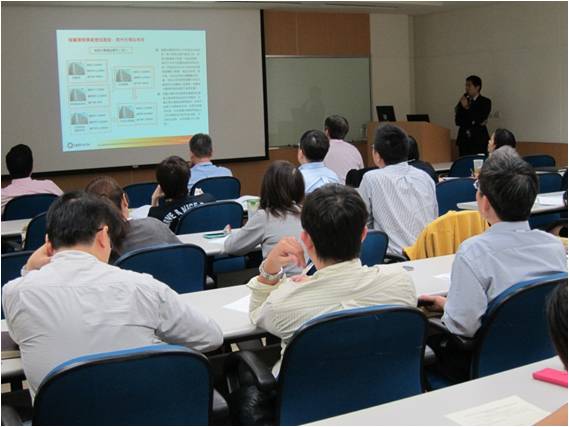Embattled Taiwanese LED packager Everlight and Japanese manufacturer Nichia both published press releases on Nov. 6, 2013 regarding their latest YAG patent dispute in China. The two companies ongoing patent wars has rekindled LED industry interests on patent issues. Aside from potential patent disputes from Nichia, Taiwanese manufacturers should also pay attention to Philips patent alliance formation, said Hsieh Chia-fen, Engineer for Electronics and Optoelectronics Technologies at Taiwan’s Industrial Technology Research Institute (ITRI). Zhaga Consortium’s claimed shared patents are not actually “free”; and China’s tsunami of LED patent applications might also become a potential threat. Hsieh made the remarks during the recent ITRI “LED lighting-market overview and patent strategy forum”.
 |
|
Attendees listen attentively to a talk delivered by a speaker at the “LED lighting-market overview and patent strategy forum”. (LEDinside) |
The global patent war ignited by Everlight and Nichia is far from reaching ceasefire. Nichia announced the Beijing No. 1 Intermediate People’s Court had revoked Everlight’s request to reverse the court’s decision. The court upheld its ruling that two Nichia YAG patents ZL97196762.8 and ZL03159595.2 were valid. Everlight also issued a press release later on the same day noting after the first and second trial Nichia’s YAG patents validity had been limited to only partially valid. Everlight emphasized the court rulings had no effect on the company’s lighting strategy.
Taiwanese LED packagers including Everlight, Unity Opto Technology Co. (Unity Opto), Harvatek and others were also engaged in patent lawsuits with Nichia was also mentioned during the forum. One of the threats to Taiwan’s LED lighting industry has been Nichia’s patents. From Nicha’s patent strategy it can be observed the company had previously launched patent lawsuits against main competitors in Europe and U.S. over phosphor material and concentration analysis from its white light module patents.
Accompanying the LED industry’s takeoff, LED manufacturers are also setting up their lighting patent strategy. Big international LED brand Philips global strategy has been acquiring large numbers of LED patents, and forming alliances with other patent holders to establish a Philips lighting patent authorization alliance. The alliance has been using patent infringement lawsuits as a measure to urge other large international LED brands to authorize patents with the alliance.
Hsieh also mentioned potential patent threats accompanying Zhaga Consortium’s development. One of the risks worth noting is the massive number of patent applications from Chinese manufacturers that can pose a potential threat in the future. The number of Chinese applications has risen rapidly over the last few years, but on average most of Chinese manufacturers applications has been focused on sheer volume and not quality. In terms of patent application types, Chinese manufacturers tend to apply for new patents with pragmatic applications, while international brands and Taiwanese manufacturers have mostly been applying for invention patents in China.
In addition, during the forum it can be observed that Taiwanese manufacturers patent strategies contains many advantageous patents. For instance, Epistar’s ITO production process and high voltage LED chips can undertake 2W to 10W missions, and is particularly suitable for bulb applications. Moreover, in the bonding technology field the company also has many important patents to protect flip chip and GaN on Si technology. Compared to San’an Opto recent acquisition of Luminus photonic crystal patent, Taiwanese manufacturer Lutatelk Corp.’s photonic quasi crystal technology patent has the advantages of achieving better light extraction efficiency and symmetrical optical field. Harvatek’s single pad wiring-bonding technology applied in COB packaging has also set up its own patent strategy.
However, compared to major international brands lighting patent strategy, Taiwanese manufacturers still lack key patents in lighting applications. ITRI’s R&D division has recently proposed a few solutions in hopes of bridging Taiwanese LED industry’s patent strategy gap.












